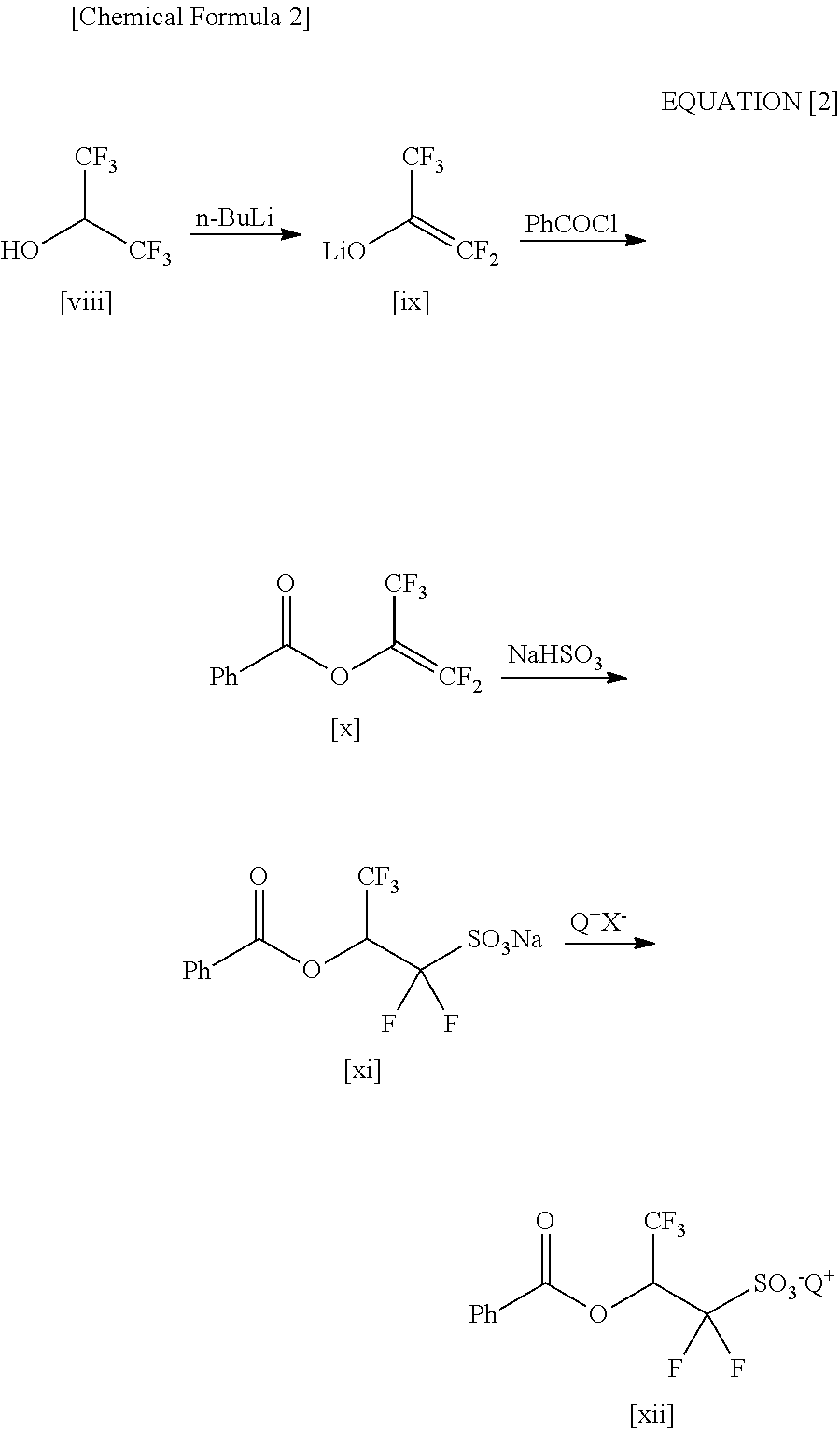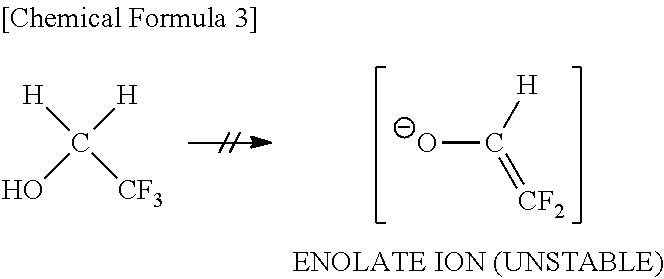2-(Alkylcarbonyloxy)-1, 1-Difluoroethanesulfonic Acid Salt and Method for Producing the Same
a technology of ethanesulfonic acid salt and alkylcarbonyloxy, which is applied in the field of alkylcarbonyloxy 1 and the production method of the same, can solve the problems of high chemical reactivity, high degree of industrial difficulty of reaction, and high risk of explosion, and achieve the effect of less operational burden
- Summary
- Abstract
- Description
- Claims
- Application Information
AI Technical Summary
Benefits of technology
Problems solved by technology
Method used
Image
Examples
example 1-1
[Production of (2′-Bromo-2′,2′-difluoro)ethyl 1-adamantanecarboxylate] (Preprocess; Esterification process 1)
[0216]
[0217]A 300 mL reactor was charged, under nitrogen, with 14.2 g (71.3 millimoles) of 1-adamantanecarbonyl chloride and 120 mL of THF (), followed by putting it in an iced bath. There, 16.1 g (92% purity, 91.8 millimoles / 1.29 equivalents) of 2-bromo-2,2-difluoroethanol was added, and 10.1 g (99.8 millimoles / 1.4 equivalents) of triethylamine was added dropwise. After the dropping, stirring was conducted at 60° C. for 23 hours. Then, 50 mL of water was added thereto, and extraction was conducted two times with 150 mL of diisopropyl ether. The obtained organic layer was further rinsed with diluted hydrochloric acid, sodium bicarbonate water and brine, followed by removing water content with sodium sulfate, filtration, and then distilling isopropyl ether off, thereby obtaining 23.2 g of the target 2′-bromo-2′,2′-difluoroethyl 1-adamantanecarboxylate. In this case, the purity...
example 1-2
Production of Triethylammonium 2-(1-adamantane)carbonyloxy-1,1-difluoroethanesulfinate
[0220]
[0221]A 200 mL reactor was charged with 18.0 g (97% purity, 54.0 millimoles) of (2′-bromo-2′,2′-difluoro)ethyl 1-adamantanecarboxylate, 50 g of acetonitrile, 40 g of water, 15.0 g (86.4 millimoles / 1.6 equivalents) of sodium dithionite and 9.8 g (97.2 millimoles / 1.8 equivalents) of triethylamine in this order, followed by stirring for 1 hour at room temperature. A reaction liquid was separated into an organic layer and a water layer. The organic layer was subjected to the distillation of acetonitrile and the addition of 40 mL of dichloromethane, thereby obtaining a dichloromethane solution. The water layer was extracted with 20 mL of dichloromethane and then mixed with the organic layer. The obtained organic layer was rinsed with 10% sodium thiosulfate aqueous solution, water and brine, followed by distilling dichloromethane out thereof, thereby obtaining 23.2 g of the target triethylammonium ...
example 1-3
[Production of Triethylammonium 2-(1-adamantane)carbonyloxy-1,1-difluoroethanesulfonate] (The 2nd Process: Oxidation Process)
[0224]
[0225]A 200 mL reactor was charged with 23.2 g (82% purity, 46.4 millimoles) of triethylammonium 2-(1-adamantane)carbonyloxy-1,1-difluoroethanesulfinate obtained by Example 1-2, 100 mL of water, 0.023 g (0.070 millimole / 0.0015 equivalent) of disodium tungstate dihydrate and 7.4 g (65.0 millimoles / 1.4 equivalents) of 30% hydrogen peroxide solution, followed by stirring for 3 hours at room temperature. Thereafter, this reaction solution was checked by using 19F NMR, with which it was confirmed that triethylammonium 2-(1-adamantane)carbonyloxy-1,1-difluoroethane sulfinate was completely consumed and that (2′-bromo-2′,2′-difluoro)ethyl 1-adamantanecarboxylate formed as a by-product was less than 1%. The reaction solution was extracted with 40 mL of dichloromethane two times, and then a solvent was distilled out of the obtained organic layer, followed by dryi...
PUM
| Property | Measurement | Unit |
|---|---|---|
| wavelength | aaaaa | aaaaa |
| solubility | aaaaa | aaaaa |
| acid strength | aaaaa | aaaaa |
Abstract
Description
Claims
Application Information
 Login to View More
Login to View More - R&D
- Intellectual Property
- Life Sciences
- Materials
- Tech Scout
- Unparalleled Data Quality
- Higher Quality Content
- 60% Fewer Hallucinations
Browse by: Latest US Patents, China's latest patents, Technical Efficacy Thesaurus, Application Domain, Technology Topic, Popular Technical Reports.
© 2025 PatSnap. All rights reserved.Legal|Privacy policy|Modern Slavery Act Transparency Statement|Sitemap|About US| Contact US: help@patsnap.com



